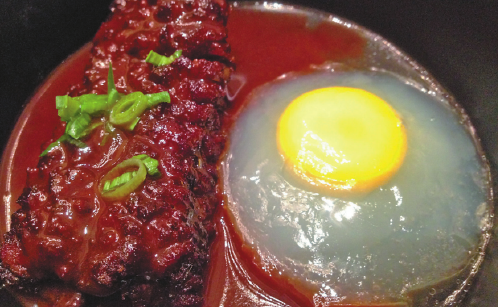
Finger-sized river eels are filleted and beaten with a rolling pin to tenderize the meat. They are braised in a sweet and savory sauce.[ PAULINE D. LOH/CHINA DAILY]
Fresh flavors and artful kitchen skills combine to make the food of the Yangtze region a universal favorite even among Chinese gourmets stubbornly faithful to their home cuisines. Pauline D. Loh explores the reasons why.
There is a vegetable that grows along the rivers and lakes in Jiangsu that makes grown men cry when they remember its taste. It is a weed, a species of mugwort that used to grow wild abundantly, but is now mostly cultivated.
Luhao, or water Artemisia, is valued for its sweet crunchiness. Only the stems are used, and they are stir-fried, usually with delicate batons of the region's equally famous five-spiced hard beancurd.
Some have compared the taste of luhao to asparagus, only immensely more subtle.
Subtlety is a signature of Huaiyang food as the collective cuisine of the region is known, and luhao is only one of the many ingredients that reflect this style of eating and cooking.
At Richesse Chinoise, the Chinese restaurant in the Fairmont Nanjing, the Huaiyang chefs pride themselves in continuing the tradition of using only the freshest, seasonal ingredients. They took me to market to show me exactly how much it mattered.
Chef Meng Xianfeng is an experienced Huaiyang chef schooled in the traditional kitchen and his eagle eye roamed over the gathered produce with radar precision.
We visited shops offering tubs of wriggling river eels, and he tells me what is best for which dish. There are fresh abalones, sea cucumbers and huge river clams to make a milky sweet broth, bullfrogs that weigh in at about a kilogram each, and fishes like the ubiquitous crucian carp, snakehead and the much rarer and more expensive mandarin fish.
What caught my eye were tiny transparent crustaceans, which Meng says are the white lake or river shrimps, something else my colleagues from Jiangsu had spoken of with great longing.
It was at the vegetable section that Nanjing showed off its best produce. There was such a lot of green that it made me misty-eyed thinking of the pale winter cabbages and radishes of Beijing.
Among the green, though, were the lighter-colored water Artemisia, piled high like very slender asparagus everywhere. Meng tells me those with the red-tinged roots are wild, and they cost about twice as much as the cultivated vegetables.
Back at the restaurant, Meng and Chinese master chef Ken Luan set to work turning our day's marketing into an exceptional lunch.
First up was a bowl of clear broth in which sat a giant meatball. It wore a mane of shredded beancurd skin, and I realized I was looking at the famous "lion's head".
This is nothing like the red-braised meatballs north of the Yangtze, deep-fried and brown-braised and shrouded with a sticky brown sauce, heavily scented with star anise.
The Nanjing version is light as Tinkerbelle's touch, melt-in-the-mouth tender and held together by kitchen magic. It is also a showcase of the chef's skill. Lean meat with just a modicum of fat is hand-minced and then repeatedly slapped against the side of a bowl until it binds.
The meatball has the texture of tofu and is white with the natural protein released in the cooking.
Master chef Luan places a platter of smoked fish on the table and says it's a "little appetizer". The slices are tender and savory and the palate is awakened by the oddly sweet smokiness of the skin. Accompanying the fish is a pile of bright green sprouts, which the chef says are grown from black beans.
It was the next dish, however, that captured my total attention.
The presentation was nothing fancy and it looked like a stir-fry Mama can turn out in her kitchen, but the first taste told me different.
